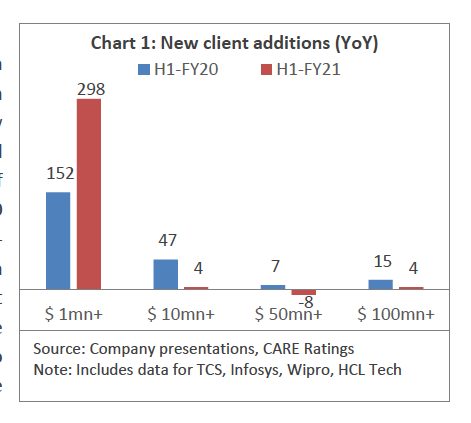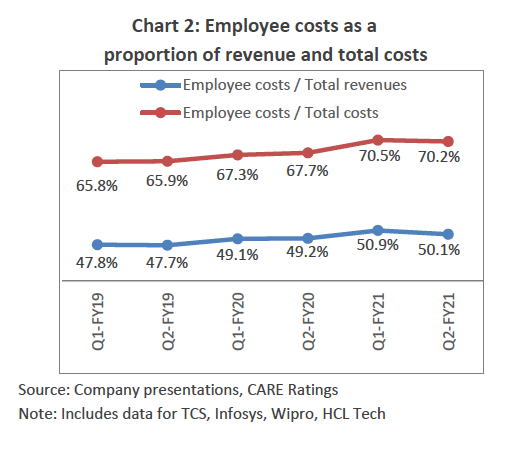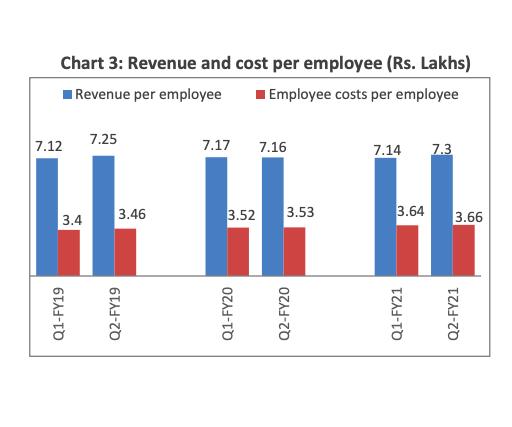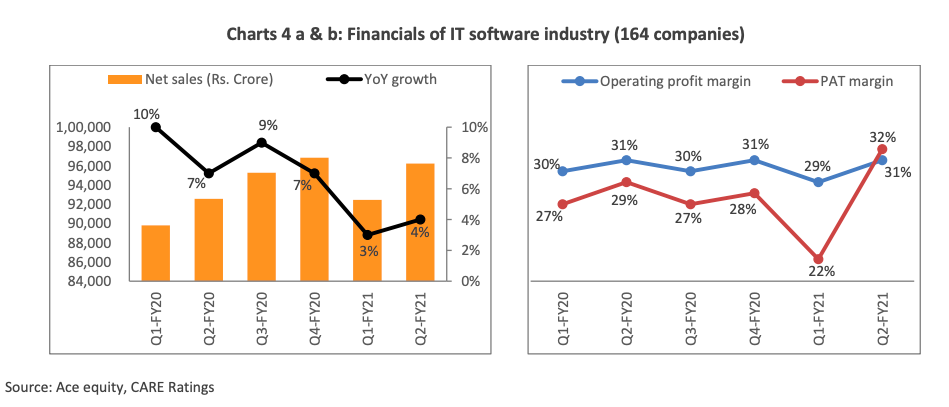Bengaluru, NFAPost: In the calendar year 2019, the global market for software and services is estimated to have grown to $1.5 trillion. IT services is estimated to have grown by 3.5% YoY, characterised by a shift to digital technologies, and adoption of DevOps, and as-a-service models.
Business Process Management (BPO) grew by 4.5% over the prior year driven by a greater focus on robotic process automation as customers automate repetitive tasks and focus on strategic work.
In the first quarter of FY21, global growth took a sharp hit in global economic activities as uncertainties rose due to the ongoing pandemic. According to Nasscom, revenues of the IT-BPM industry in the first quarter of FY21 declined 6% Q-o-Q, with nearly all regions witnessing a fall in demand, while the European market exhibited some resilience. A similar trend was witnessed in most industry verticals, with BFSI vertical performing marginally better than the rest.
The ongoing pandemic has acted as one of the biggest catalysts for digital transformation in most firms across the globe. After a softness in the initial part of Q1-FY21, recovery was quick.
As the quarter progressed, deal wins grew, operating margins expanded, employee attrition fell, utilisation levels rose and cash flows rose for the Indian IT services industry.
The following sections are an analysis of the client metrics, performance of various industry verticals and geographical regions, growth in employee strength in H1-FY21 based on data from top four players operating in the IT services industry. These 4 players accounted for 80% of the total revenues generated by the industry in H1-FY21.

Client metrics
Analysis of table on right shows that a total of 221 new clients were added in the four bands of $1 mn+, 10 mn+, 50
mn+ and 100 mn+ in H1-FY20. Though the new client additions have risen in H1-FY21 to 298, most of these were concentrated in the lowest band of $1 mn+.
This shows that H1-FY21 was characterized by a much larger volume of relatively smaller sized deals, due to the fall in technology budgets of corporates, when compared with previous year.
The order book in past few months of this pandemic year comprised deals related to digital transformation where a large part of these focused-on cloud migration. Other deals related to increasing cost efficiency by implementing automation,
making better use of the existing IT infrastructure and further modernizing it.
Performance of industry verticals
Nearly all business verticals were imapcted with revenue declines of varying degrees in H1-FY21. The retail segment was
under pressure as clients in the non-grocery, apparels, lifestyle & fashion, restaurants, logistics segments witnessed demand contraction and supply chain disruptions, while the transportation and hospitality segment suffered due to travel restrictions.
The communications vertical was under pressure as covid-19 related disruptions led to delays in 5G rollouts, while the media & entertainment industry was impacted by cancellation of big sporting and entertainment events and weaker advertisement spending.
Growth in the manufacturing vertical weakened in Q1-FY21 as most production activities came to a halt in initial weeks of the quarter. The demand and supply chain disruptions persisted in the following quarter as well. Disruptions across subsegments continued and hence the pace of recovery remained sluggish.
However, performance stabilized in later part of Q2- FY21. The automotive and aerospace sectors were negatively impacted due to factory closures and delays or cancellations in aircraft purchases. The energy, utility and resources vertical were under pressure due to constrained spending in the oil and gas sector.
The BFSI vertical, after an initial drop in early part of Q1-FY21 witnessed a faster recovery in business volumes and deals especially in USA and APAC banking, where areas of spend included adoption of open banking, payments, insights-driven customer experience, automation, robo-advisory systems, etc.
The good performance of the vertical continued in Q2-FY21 with increased traction in mortgage servicing, call centre technology and operations, etc. The life Sciences and healthcare vertical outshone by growing at a healthy pace
Performance of geographical markets
Performance of most geographical markets declined in Q1-FY21, with the exception of Europe. However, in Q2-FY21, USA and rest of the world gained some pace.
Also, performance of various industries differed in various markets as BFSI was better in USA, while in other industries Europe performed better. Alongside, Indian IT services players introduced new services to cater to the varying demands of clients.
Employee strength

The total headcount at the end of H1-FY21 stood at 20.47 lakhs, a marginal rise of 2.3% when compared with 9.2% in H1- FY20. The net new additions stood at 30,580 (-64% YoY) in Q1-FY21 and 16,276 (-80.6% YoY) in Q2-FY21, and translates to a significant fall in total net additions of 1.21 lakhs in H1-FY21.
Usually, the first half of every financial year exhibits higher attrition as junior level employees leave the organisations to pursue further studies. However, as the macro environment was grappling with multiple uncertainties in H1-FY21, attrition rates dropped.
Chart 2 shows that employee costs as a proportion of total revenues rose in the past three years from 47.8% in Q1-FY19 to 50.1% in Q2-FY21. Alongside, employee costs as a proportion of total costs grew from 65.8% in FY19 to 70.2% in FY21. The aggregate employee costs for top 4 players of the industry rose 5.9% YoY to ~Rs. 74,700 crores in H1-FY21. This rise in employee costs can be attributed to the growth in number of employees over a period of time and their regular salary revisions. Also, employees that can work on newer and emerging technologies like machine learning, blockchain, IoT, 5G, among others are recruited at higher pay scales.
Per employee revenue
Chart 3 depicts revenue generated per employee and employee costs incurred per employee – where the former ratio fell and the latter rose sequentially in Q1-FY21.
However, in Q2-FY21 both the ratios rose sequentially. In these two quarters, cost avoidance measures like hiring freeze, reskilling bench talent to improve utilisation etc. were implemented to reduce margin deterioration. Additionally, temporary workforce was downsized and replaced with the existing slack in the system, which led to improvement in utilization levels.
Most of the delivery centres of IT services players located across the globe remained closed in H1-FY21 and hence, a vast majority of the employees delivered their work from home. Due to the imposition of travel restrictions, a favourable onsite and offshore mix helped reduce overall employee cost. However, this is temporary for few months, as the onsite work is expected to rise with easing of travel restrictions in future.
For the rest of FY21 and FY22, fresher hiring target are expected to remain unchanged, despite the attrition rates falling in H1-FY21, due to more deal wins which creates a demand for skills in emerging areas. If needed, adjustments may be made to lateral hiring based on business demands.

Non-immigrant visas
The IT services industry requiresfree movement of people across nations and any restrictions in key markets could potentially cause project delays and increased costs.
The USA is one of the largest markets for Indian IT service players. The USA government in the past 3-4 years was seen creating uncertainties and bringing policy changes that were considered a deterrent to the growth of the visa dependent technology outsourcing industry.
A few days before the US elections, the government proposed to not issue temporary business visas for H-1B speciality occupations. This new proposal follows a series of such initiatives that the US government had taken earlier, in an attempt to control the rising unemployment rates in the country and encourage local hiring.
Some of these included hiking the minimum wages for non-immigrant visa holders (for transfers and extensions) and increasing the visa processing fee. In response to the changing political scenario and rising regulatory challenges, Indian IT services companies over the past few years have increased their localisation efforts, made use of contractors and increased training. In the ongoing pandemic, migrating to a remote working model also helped mitigate the risks associated with the approval of such visas.
Policy direction
While a new government has been elected in the recently held USA elections, not much is anticipated on the new policy
direction. However, we do not expect it to be as extreme as the previous government.
Any decisions on immigration and work visas are crucial for the industry, as Indian and offshore focused IT outsourcing services industry has been dependent on these short-term business visas given the type of business model they operate in.
This is essential not only for the Indian IT services players but also for US-headquartered tech giants like Amazon, Google, Microsoft, Facebook, IBM, etc. USA is grappling with a supply shortage of technology skills that companies require and the key challenge is in sourcing the required STEM talent.
According to U.S. Citizenship & Immigration Services, 1.74 lakh H-1B visa petitions (-15.8% YoY) were received during April – June 2020. About 1.02 lakh visa petitions were processed this quarter, out of which 95.9% were approved. In a similar period last year, 1.28 lakh petitions were processed and 90.9% were approved.
Financial performance
While the industry lagged in the first quarter of FY21, it demonstrated a strong rebound in Q2-FY21 across all parameters, backed by growth across key verticals and geographies. The charts 4 (a) and (b) depicts quarterly financials of the previous and ongoing financial year for 164 companies.

The first quarter of FY21 witnessed a demand contraction which got reflected in the net sales as well as margins. To control further fall in margins, IT services players indulged in short term discretionary cost cuts, some of which were enforced by Covid-19 like travel and visa costs, lower selling, general and administrative expenses, rate negotiation with vendors, etc. The volatility in Rupee and higher onsite mix in first-quarter acted as headwinds.
A greater stability was seen in Q2-FY21. A higher offshore mix, improved utilization levels, lower employee attrition and the benefits of lower subcontracting aided the improvements in margins, while the adverse movement of Rupee created
pressures. The free cash flows grew supported by robust collections, despite some client extension requests.
Additionally, the stimulus provided by governments to companies helped in improving cash collections. As the quarter progressed, clients accelerated their technology investments to fuel their recovery process and IT services players launched new services and products to cater to an expanding set of clients for revenue generation.
A broad-based growth across most markets and industry verticals helped the industry rebound reach pre-covid levels in Q2-FY21.
Concluding remarks
- In the initial part of Q1-FY21, the top IT services players witnessed a drop in demand, but as the quarter progressed,
a fast recovery in business volumes and deals was shown. In the ongoing pandemic, large number of clients are
undergoing a change in their business models and increased spends on upgrading technologies to stay relevant.
While the number of client additions rose in H1-FY21, the size of deals became smaller. - Financial Services, life Sciences and healthcare segments outshone in H1-FY21, while communications,
manufacturing and energy, utilities and resources segments lagged. Geography wise, Europe performed better than
the rest.
Outlook
Lockdowns and social distancing restrictions on account of the pandemic significantly impacted economic activity in all major markets, and caused demand compression in initial months of the pandemic.
According to IMF (projections released in October 2020), the global economy is expected to contract 4.4% in 2020. However, a better-than-anticipated second and third quarter GDP outturns, as activities improved sooner than expected, will help the global economy to recover faster going forward.
The global growth is projected at 5.2% in 2021. However, the consistent rise in Covid-19 cases in developing as well as developed economies, acts as a threat to the global economic growth.
- We remain positive about the future prospects of the Indian IT services industry as it is well positioned to take advantage of the opportunities that come in near future. The pandemic has proved that any company that have not invested enough in their digital transformation over the last years, have felt the pain in the ongoing crisis. Henceforth, technology will play a pivotal role in helping enterprises to adapt to the new normal. Companies are expected to invest more towards building operational resilience, analytics, automation, cloud and cyber security, etc. As the deal momentum picks up in latter half of FY21, hiring shall gain pace with revenue and margin growth expected to be strong, however, rolling out salary hikes and promotions along with higher overhead and travel costs
could act as a headwind for H2-FY21 margins. - Q3 has traditionally been a weak quarter seasonally with a greater number of holidays and hence not many new projects are taken up. However, we expect Q3 of FY21 shall be better, with furloughs lower than normal, as large number of employees still continue to work from home.
- According to RBI, software exports in the first quarter of FY21 stood at USD 22.6 bn, lowest since Q4-FY19, although comparison on a YoY and QoQ basis shows the degree of fall is marginal at -0.9% and -2.9% respectively. Hence forward, we expect exports to pick up.
(The above story is based on CARE Rating report)





